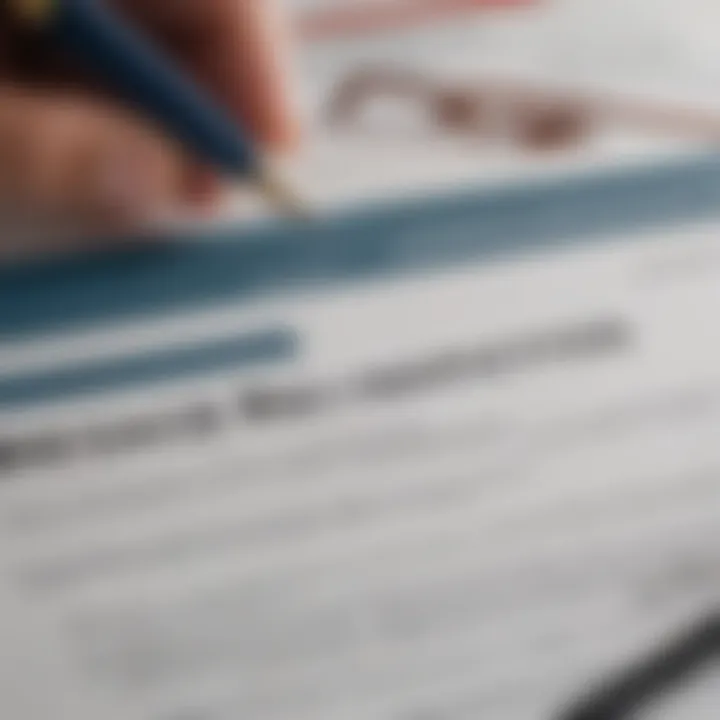Understanding VA IRRRL Streamline Refinance Benefits


Intro
In today’s financial landscape, many veterans and military personnel find themselves grappling with the complexities of mortgage refinancing. Among the range of options available, the VA IRRRL streamline refinance program stands out as a beneficial avenue tailored for those who have defended our nation. This narrative provides a thorough understanding of what IRRRL entails, its integral components, and how it measures against other refinancing choices. Familiarizing oneself with the VA IRRRL process can prove invaluable for making sound financial decisions.
The streamline refinance option is not just any run-of-the-mill solution. It's specifically designed to prioritize the needs of veterans. By cutting through the red tape typically associated with traditional refinancing, the IRRRL program simplifies the experience, making it easier for those who have served to take advantage of potential loan savings. It eliminates unnecessary hurdles which might stem from income verification or credit checks that often loom large in any homeowner’s refinancing journey.
As we dive deeper into the details, we will explore important facets such as common terms, the technical jargon that frequently bogs down understanding, and practical insights that can empower veterans to navigate this process effectively. In bridging the gap between military experience and financial literacy, our goal is to provide clarity and confidence to those considering this path.
Investment Dictionary
Understanding any financial product starts with grasping the language that accompanies it. Let's dissect some essential concepts related to the VA IRRRL streamline refinance program.
Definition of Key Terms
- IRRRL: This stands for Interest Rate Reduction Refinance Loan. It is a specific type of VA loan that simplifies the process of refinancing by allowing for less documentation and fewer fees.
- Cash Out Refinance: Unlike the IRRRL, this option lets you borrow more than your current mortgage balance and take the extra cash. It can be beneficial, but it comes with different requirements and may not offer the same lower interest rate benefits.
- Loan-to-Value (LTV) Ratio: This ratio compares your loan amount to the current appraised value of your home. A lower LTV is generally more favorable and indicates less risk for lenders.
- Fixed-Rate Mortgage: A loan type where the interest rate remains the same throughout the life of the loan. This predictability can make budgeting easier for homeowners.
Commonly Used Financial Concepts
Understanding these terms lays a solid foundation for engaging with the broader topic of refinancing. In addition to the specific New York terms mentioned above, knowing concepts like interest rates, amortization, and equity is crucial. Interest rates determine how much you pay over time; amortization refers to how payments are structured over the life of a loan, and equity represents the portion of your home you truly own.
It’s vital to have a firm grasp on these definitions, as they empower veterans with the knowledge necessary to navigate an often overwhelming financial landscape. Without this comprehension, one risks falling prey to misunderstandings and potentially costly mistakes. In the following sections, we will take a closer look at potential strategies for leveraging the benefits of the VA IRRRL streamline refinance program.
Prelims to VA IRRRL Streamline Refinance
Navigating the world of refinancing can often feel as complicated as untangling a set of Christmas lights. In the case of VA IRRRL (Interest Rate Reduction Refinance Loan), things can seem particularly perplexing to many veterans and military personnel. This article aims to shed light on this financial option that's tailored for those who have served.
Understanding the VA IRRRL streamline refinance is crucial for anyone looking to reduce their monthly payments or secure better loan terms without getting bogged down by excess paperwork. Unlike conventional refinancing processes, which can resemble a labyrinth, VA IRRRL offers a pathway that prioritizes efficiency and simplicity, making it ideal for those who have limited time or energy due to their service commitments. In addition, veterans often carry special financial considerations that might not apply to the average borrower.
The key benefits of a VA IRRRL refinance include potentially lower interest rates, reduced fees compared to traditional refinancing options, and the opportunity to finance closing costs within the loan. So, it’s not just about saving money; it's a chance to reshape one’s financial future. Take note, though, that understanding what this process entails and who qualifies can make all the difference in achieving a successful refinance. By the end of this article, readers should have a clear grasp of the VA IRRRL process—think of it as a map to guide them through possible financial complexities.
Understanding Streamline Refinancing
At its core, streamline refinancing is all about efficiency. It allows borrowers to refinance their existing loan in a more straightforward manner compared to traditional refinancing options. In the context of VA IRRRL, streamline means that veterans can avoid much of the usual hassle, such as endless documentation and credit checks, provided they meet some basic criteria.
Essentially, with VA IRRRL, the main focus is on reducing monthly mortgage payments. It can be seen as a way to take the tedious multi-step process of refinancing and condense it into a few crucial, manageable steps. Notably, this path is designed to minimize any disruption to the homeowner's life, which can be particularly important for those whose daily lives might already be burdened with service-related commitments.
Key Objectives of VA IRRRL
The primary goals of the VA IRRRL program are centered around financial relief for veterans. Here are some objectives that stand out:
- Lower Interest Rates: As the name implies, the primary goal is to reduce the interest rate on existing loans, thereby lower monthly payments.
- Simplicity: The process is designed to be as uncomplicated as possible, which helps veterans save time and reduce stress.
- No Out-of-Pocket Expenses: Most of the fees can be included in the new loan, allowing veterans to engage in refinancing without the need to dip into their savings.
- Easy Transferability: Another advantage is that homeowners don't necessarily have to switch lenders; they can often refinance with the original lender.
In summary, the overarching aim of VA IRRRL is to put more money back into the pockets of veterans, enabling them to focus on what truly matters in their lives, rather than the complexities of their financing options.
Defining VA IRRRL
Understanding the VA IRRRL is crucial to fully grasping how it can support veterans and their families in managing their financial burdens. It’s not just about securing a lower interest rate; the program veils multiple layers of benefits, qualifications, and process peculiarities that warrant exploration. By delineating the essence of VA IRRRL, veterans can better assess if this refinancing route aligns with their financial strategy, while lenders can connect more effectively with potential clients seeking these specialized loans.
What Does VA Stand For?
When discussing VA IRRRL, it’s important to first clarify what the acronym VA signifies. VA stands for the Department of Veterans Affairs, an arm of the U.S. government created to assist military service members, veterans, and their dependents. The department provides a variety of services, but within the context of IRRRL, it empowers veterans to refinance existing VA loans to achieve better loan terms.
The program’s roots lie in the desire to offer financial relief to veterans, who might be grappling with high-interest rates or changing economic conditions. The backing of the VA lends a protective layer as lenders often feel more comfortable extending loans under its umbrella. Veterans should take comfort in knowing that this program is tailored specifically for them, reflecting the nation’s recognition of their service.
The Concept of Interest Rate Reduction
At the heart of VA IRRRL lies the fundamental concept of interest rate reduction. This straightforward idea holds immense significance for those looking to ease their monthly financial commitments. Effectively, the program allows veterans to refinance their existing VA home loan to secure a lower interest rate, reducing the burden of monthly payments.
What makes this concept attractive is the swift and streamlined process it promotes. Unlike conventional refinancing routes, the VA IRRRL does not require a full underwriting process. This policy exists to facilitate the approval of loans promptly, ensuring veterans can seize favorable market conditions. By participating in the VA IRRRL program, veterans can enjoy the potential for:


- Lower monthly payments: This can lead to significant annual savings.
- Potentially shortening the loan term: Opting for a shorter repayment duration can sometimes offer even greater long-term savings.
- Increasing stability: A lower interest rate often translates into improved budget management, positively affecting life quality.
"For many veterans, taking the leap into the VA IRRRL process can equate to financial empowerment—it's about making the numbers work for them, not against them."
This concept is not merely an accounting strategy; it reflects a broader endeavor to assist veterans in achieving their own financial dreams. It's an opportunity born from the unwavering commitment to those who have served, meeting their needs in an evolving financial landscape.
Eligibility Requirements
Understanding the eligibility criteria for the VA IRRRL streamline refinance is pivotal for veterans and military personnel seeking to optimize their financial situation. This section discusses the essentials of eligibility, informing readers about who qualifies and what documents are necessary for those interested in the program.
Who Qualifies for VA IRRRL?
To be considered for the VA IRRRL, applicants need to meet certain qualifications that largely focus on military service and existing VA loans. Here are the key criteria:
- Veteran Status: You must have served in the military, and your discharge status should typically be honorable. This basic criterion is non-negotiable.
- Existing VA Loan: Applicants should already possess a VA-backed mortgage. This program is specifically tailored for individuals already benefiting from a VA loan.
- Obtaining a Lower Interest Rate: A primary goal of the IRRRL is to reduce your monthly payments by securing a lower interest rate. If you're not currently experiencing this, it could affect your eligibility.
It’s important to note that VA IRRRL is not limited by income or credit scores, which makes it stand out against traditional refinancing options. This opens the door for many who might otherwise struggle with stringent eligibility requirements. An essential element to remember is that even if you've had a prior default in loans, you still may qualify, subject to certain conditions.
Required Documentation for Applicants
When diving into the IRRRL process, ensure you have the right paperwork drawn up. Here’s a concise list of documents you might need:
- Certificate of Eligibility (COE): This document proves your veteran status to lenders. You can apply for it through the VA if you don’t have one already.
- Current Loan Information: Details about your existing VA loan, including account numbers and current balance, are necessary to facilitate the refinancing process.
- Proof of Residency: Lenders often require documentation ensuring that the property is occupied by you, the borrower. This is typically verified through utility bills or tax documents.
- Income Verification: Though not the primary focus of VA IRRRL, some lenders may ask for a basic income statement to verify your ability to manage new payments.
In summary, while the VA IRRRL keeps the process simple, gathering required documentation efficiently can streamline your application journey. Proper preparation can significantly alleviate potential stress.
"Knowing what you need before you apply can save you a heap of time and keep the process running smoothly."
In essence, understanding the eligibility requirements and preparing the necessary documents not only sets the stage for a smoother refinancing experience but also ensures you can take full advantage of the benefits offered by the VA IRRRL program.
Advantages of VA IRRRL Streamline Refinance
When it comes to refinancing a mortgage, especially for veterans and military personnel, the advantages of the VA IRRRL program truly stand out. The benefits it offers are not just mere prods in the right direction; they can be the difference between struggling with high monthly payments and achieving a more balanced financial situation. Understanding the various elements of these advantages provides insight into why many eligible individuals choose this path.
Lower Interest Rates
One of the cornerstones of the VA IRRRL is the potential for lower interest rates. This aspect is particularly compelling because a reduced interest rate directly lowers monthly payments. Imagine being able to shift a significant portion of your budget from mortgage payments back into savings or investment. The beauty of this refinancing program lies in its focus on interest rate reduction, which makes it easier for veterans to better manage their finances.
Moreover, compared to conventional loans, this advantage is enhanced by the lack of the need for a credit check or appraisal, which traditionally can complicate the loan application process. Lack of these steps speeds up the whole process too. Thus, it isn't uncommon for veterans to walk away with a markedly lower interest rate than what they previously had.
Reduced Fees and Closing Costs
Another important benefit associated with VA IRRRL is the reduction of fees and closing costs. In many cases, veterans might find themselves able to refinance without bearing the typical costs that come with a traditional mortgage refinance. The VA allows for certain lender fees to be waived, and in some cases, there may even be no closing costs at all.
"The VA IRRRL can be a breath of fresh air for veterans looking to reduce financial burdens."
For those who find themselves worried about upfront costs, this is a game changer. Thanks to this program, veterans can avoid the headache of managing high closing costs, allowing for a smoother transition into better financial standing. Instead of a barrier, costs become an opportunity for savings.
Simple Application Process
The application process for VA IRRRL is notably straightforward, which is yet another perk that sets it apart from other refinancing options. For eligible veterans, the simplicity of the application process can be quite refreshing. There’s a distinct lack of complicated paperwork and excessive requirements, which can typically bog down loan applicants.
Instead, borrowers focus on providing fundamental documentation, allowing them to complete the refinancing at a much quicker pace. This operational efficiency not only saves time but also reduces stress for veterans who may already be managing other responsibilities.
Steps Involved in VA IRRRL Process
The VA IRRRL Streamline Refinance process consists of several key steps that guide eligible veterans through securing a more favorable loan. Understanding each of these steps is crucial, as it may prevent potential pitfalls and help navigate the complications often associated with the refinancing landscape. From initiating the application to finally closing the loan, every stage has its own set of requirements and benefits. The clarity gained from this breakdown can lead to better decision-making and enhanced financial stability in the long run.
Initial Application Submission


Starting this journey begins with the initial application submission. This step is often perceived as daunting, yet it’s fairly straightforward if you have the right information at hand. To get started, you’ll need to approach a VA-approved lender. They will provide you with the necessary application forms and guide you through filing them correctly.
Before submitting, gather essential documents. Your Certificate of Eligibility (COE) is vital, along with financial statements showing your income, existing mortgage details, and credit assessment. A well-prepared application can expedite later phases of the process.
It's important to note that lenders often offer support through this process, helping veterans understand the nuances of their unique situation. Sometimes, veterans feel overwhelmed by paperwork, but many lenders understand and aim to simplify it as much as possivle.
Processing and Underwriting
Following the submission of your application, your lender will move onto the next crucial phase: processing and underwriting. During this stage, your financial history and current situation will be examined meticulously.
Lenders generally review credit scores, income verification, and outstanding debts. If you’ve done your homework and cleaned up any financial blemishes, this stage may pass smoothly. Sometimes, veterans worry about their credit scores. However, many lenders focus more on your overall financial fitness rather than just a number.
The underwriting process can take time; patience here is key. Lenders are ensuring that all criteria are met for VA IRRRL eligibility, which protects both financiers and borrowers. If everything checks out, your application will move quickly to the next phase—closing.
Closing the Loan
Now, onto the final stage—closing the loan. This part represents crossing the finish line. During this meeting, important documents are signed, and the terms of the new loan are discussed in detail.
Usually, the closing involves settling any remaining fees and costs, which in the case of VA IRRRL loans, tends to be minimal compared to conventional refinancing options. The lender will walk you through each document, ensuring clarity on all aspects, from payment schedules to interest rates.
"A thorough understanding at this stage can save you from unexpected surprises down the road."
After finalizing the paperwork, your old loan will be paid off, and you will officially commence payments on your new, streamlined loan. This signifies not just the end of a process, but the beginning of a potentially more stable financial path.
Understanding these steps in the VA IRRRL process allows for a clearer view of what lies ahead, enhancing confidence in the decisions being made. Without rushing, taking the time to understand each component can lead to significant long-term benefits.
Comparing VA IRRRL with Other Refinancing Options
Navigating the landscape of refinancing can feel like finding your way through a maze. With so many options available, making an informed choice is essential. By comparing VA IRRRL to other refinancing alternatives, you can pivot toward what suits your financial situation best. Understanding these differences not only allows eligible veterans to optimize their benefits but also equips them to make decisions that align with their long-term financial goals.
Conventional Refinancing
Conventional refinancing typically requires a significant amount of documentation and a high credit score for approval. It often includes a detailed review of your financial standing, looking at everything from income to employment stability. These loans can either be fixed or adjustable-rate, but the approval criteria can be stringent.
Some aspects worth mentioning:
- Higher Closing Costs: Generally, conventional refinancing entails closing costs that can weigh heavily on your wallet. While these costs often align with industry standards, they can still feel like a burden, especially if you are looking to save.
- Private Mortgage Insurance: If your down payment is less than twenty percent of the home's value, you may need to pay for private mortgage insurance (PMI). This extra expense isn’t just a financial drag; it adds complexity to your budget.
- Less Streamlined Process: The process for conventional refinancing can take a while, leading to frustration while you await approvals and inspections. There’s often a myriad of hoops to jump through, which can feel particularly grueling.
Ultimately, while conventional refinancing can provide some benefits, its limitations might deter veterans who are looking for a simpler route to lower their rates.
FHA Streamline Refinance
The Federal Housing Administration (FHA) also offers a streamline refinance option designed to simplify the process for borrowers already holding an FHA loan. While it boasts certain benefits, it also has its parameters:
- Reduced Documentation: One significant advantage of the FHA streamline is the lower documentation requirement. Borrowers often don’t need to provide income verification or credit checks, which streamlines the process immensely.
- No Appraisal Required: Unlike other refinancing options, the FHA streamline might not require an appraisal. This can save time and money, which is a notable win.
- Mortgage Insurance Premium: FHA loans, including streamline options, do require upfront and annual mortgage insurance premiums, which can eat into any potential savings when refinancing.
In essence, while the FHA streamline does hold advantages like lower paperwork and no appraisal, it also might not provide the same level of savings compared to VA IRRRL.
Choosing the Best Option for Your Situation
When it comes to selecting the right refinancing option, it’s crucial to consider your individual financial circumstances. Here are a few elements to mull over:
- Current Loan Type: If your existing loan is a VA loan, tapping into the VA IRRRL can offer significant benefits like no credit checks or extensive documents.
- Credit Score: Your credit status plays a pivotal role. If your score is less than ideal, conventional refinancing may not be the best route.
- Long-Term Plans: Think about your future. How long do you intend to stay in your home? If you’re looking to settle down long-term, the savings from VA IRRRL could undoubtedly be beneficial.
- Financial Goals: Assess what you’re looking to achieve. Are you after lower monthly payments? Or perhaps you’re more focused on cashing out equity? Each refinancing option has its perks depending on your goals.
By weighing these aspects against the offerings of each refinancing option, you’ll position yourself to make the most advantageous decision for your unique situation.
"The key to smart refinancing lies in understanding the options available and how they play into your financial future."
In comparison, VA IRRRL presents a streamlined, veteran-friendly approach that simplifies the refinancing maze significantly. By recognizing these differences, veterans can make choices that not only save them money but also sets them up for a stronger financial future.


Common Misconceptions about VA IRRRL
Understanding the common misconceptions surrounding the VA IRRRL, or Interest Rate Reduction Refinancing Loan, is crucial for eligible veterans and military service members. Many myths can cloud the decision-making process, leading to confusion and ultimately preventing qualified applicants from taking advantage of this beneficial refinancing option. Addressing these misconceptions head-on can empower potential borrowers with accurate information and a clearer view of their options.
Myths Regarding Eligibility
One prevalent myth is that only veterans with perfect credit scores qualify for VA IRRRL refinancing. In reality, the program is designed with flexibility in mind. Unlike some traditional refinancing options that enforce strict credit requirements, the VA’s streamline refinance program allows borrowers with less-than-stellar credit scores to qualify, provided they meet other key criteria.
Another common belief is that one must have served in active duty for a certain length of time to qualify. While there are service requirements, even members of the National Guard or Reserves can qualify after meeting specific conditions. The critical point is understanding the specific eligibility requirements set forth by the VA, which can vary based on service dates and status.
Furthermore, people often think they cannot use the IRRRL if they currently have a non-VA loan. That’s not true. VA IRRRL is specifically created for veterans, and it can be used to refinance non-VA loans into a VA-backed loan, thus potentially lowering monthly payments.
Understanding VA Loan Limits
Another facet often misunderstood is the topic of VA loan limits. Many assume there is a cap on how much one can borrow under the IRRRL program. While it’s true that individual lenders may impose limits based on their underwriting guidelines, the VA no longer has specific maximum loan amounts for veterans seeking an IRRRL.
Instead, eligible borrowers can generally refinance their current VA loans without regard to limits, provided they can demonstrate financial ability to take on the new loan. This can be advantageous as it enables veterans to tap into equity in their homes more freely, perhaps making home improvements or consolidating debt.
To gain a comprehensive understanding of these misconceptions, it’s essential to dive into reliable resources or consult with a qualified VA mortgage specialist. Below is a summary of the most common myths:
- Myth 1: Only those with excellent credit can qualify.
- Myth 2: A lengthy service time is necessary.
- Myth 3: Only existing VA loans are eligible for IRRRL.
- Myth 4: VA loan limits strictly apply to IRRRL.
By addressing these misconceptions, veterans can position themselves to take full advantage of VA IRRRL's benefits, ultimately facilitating better financial decisions.
Long-Term Implications of VA IRRRL
The VA IRRRL streamline refinance program offers veterans and military personnel a convenient pathway to lower their monthly mortgage payments. Yet, its significance stretches far beyond the immediacy of interest rate reductions. Consider this: the ripple effects of engaging with the IRRRL process can influence one's financial future for years to come. Evaluating the long-term implications isn’t just an exercise in numbers; it’s about understanding how a single decision today can impact your financial landscape tomorrow.
Financial Benefits Over Time
When looking at the financial benefits, one can’t overlook how the VA IRRRL can enhance overall financial stability. Picture this: by refinancing, veterans often secure a lower interest rate. This doesn’t just mean smaller payments now; over time, those savings add up significantly.
- Comparison of Monthly Payments: A hypothetical scenario could involve a veteran refinancing from a 4% interest rate to 3%. Assuming a $200,000 loan balance, that lower rate could save around $200 a month. Over a period of ten years, that’s a whopping $24,000 saved in interest!
- Compound Benefits: Additionally, the money saved each month can be redirected. Whether it's contributing to savings, investing, or paying down other debts, these funds can be reinvested for greater financial security.
- Tax Benefits: Furthermore, lower mortgage interest may also translate into savings on taxes, depending on personal circumstances, which can contribute to long-term financial health.
"Lowering your rate is not just about today’s payment; it’s about how you manage that money moving forward."
Impact on Credit Scores
Understanding how VA IRRRL affects a borrower’s credit scores is equally vital. While some may worry refinancing might ding their scores temporarily, the reality can be quite beneficial in the long run.
- Credit Utilization: Refinancing might allow the borrower to pay off other high-interest debts. Reducing credit utilization in other areas usually leads to an improved credit score, assuming other factors remain constant.
- Establishing a Positive Payment History: As the veteran begins making consistent payments on a new mortgage at a lower rate, this can contribute positively to their credit profile over time.
- Longevity of Credit Accounts: Maintaining a longer history with the new loan can also reflect positively. Given that credit history length accounts for a portion of the credit score calculation, remaining with the VA loan for a longer duration can play in the borrower’s favor.
In essence, when undertaking the VA IRRRL, it’s crucial to consider both the immediate advantages and the long-term implications. Understanding the broader picture can help veterans navigate their finances more effectively, ultimately guiding them toward sound financial decisions.
Final Thoughts on VA IRRRL Streamline Refinance
Navigating the world of refinancing can feel like trying to read a map in a foreign language. The VA IRRRL Streamline Refinance program offers specific advantages that can make the process smoother for eligible veterans and military personnel. Through this in-depth exploration, it's clear that understanding your options is crucial for making informed financial decisions.
Is VA IRRRL Right for You?
Determining if the VA IRRRL is the right move hinges on several factors. First and foremost, evaluate your current financial situation. If you are sitting on a higher interest rate from a previous VA loan, switching to a lower rate could save you a hefty sum over time, enhancing your monthly cash flow. The application process tends to be less cumbersome than traditional refinancing, which can be an essential consideration if timelines are tight.
Before jumping in, assess your eligibility. Veterans, active-duty members, and certain surviving spouses can qualify, but it’s prudent to ensure you meet the necessary criteria. It's like checking your gear before a climb; a little preparation can prevent a lot of headaches later.
Moreover, think about your long-term goals. If you're planning to stay in your home for a while, the savings associated with interest rate reductions could add up significantly. In contrast, if you're contemplating a move soon, the benefits may not be as pronounced.
Resources for Further Learning
The depth of knowledge around VA IRRRL can be quite overwhelming. Here are some valuable resources that may help you delve deeper:
- Wikipedia: VA Loan: Offers a comprehensive overview of VA loans, including refinancing options.
- Britannica: Understanding Mortgage Refinancing: This resource helps you understand the broader context of refinancing and its implications.
- Reddit: VA Loan Community: A great place to engage with others who have been through the VA IRRRL process. Real experiences can provide insights that average guides might miss.
- Facebook: VA Loan Support Groups: Consider joining communities that focus on VA loans for advice and updates from fellow veterans.
"Knowledge is like a map; it won’t navigate your journey, but it can guide you on where to go."
In closing, the decision to pursue a VA IRRRL should be grounded in thorough research and consideration of personal circumstances. By weighing the pros and cons and utilizing available resources, veterans can empower themselves to make sound decisions. Remember, refinancing is not just about lowering rates—it's about securing a sustainable financial future.



